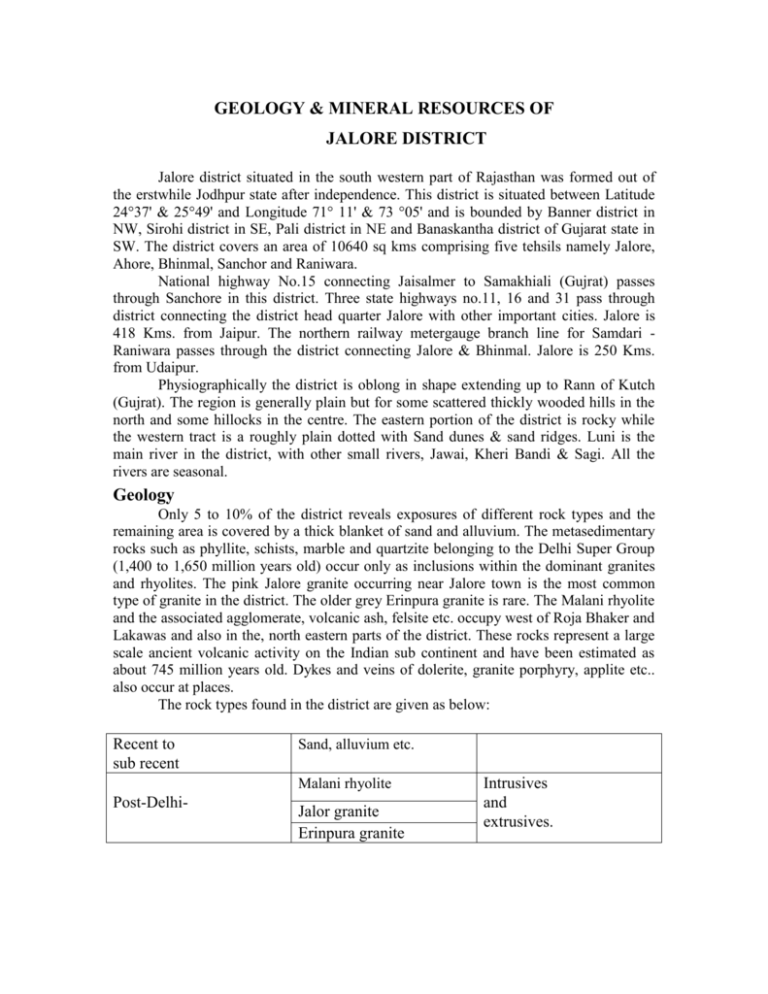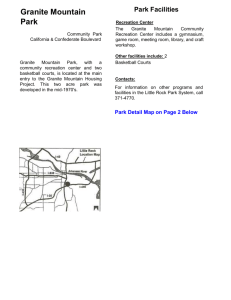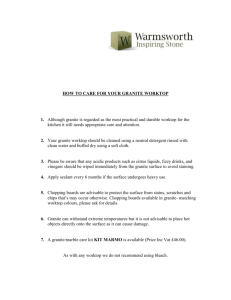GEOLOGY & MINERAL RESOURCES OF
advertisement

GEOLOGY & MINERAL RESOURCES OF JALORE DISTRICT Jalore district situated in the south western part of Rajasthan was formed out of the erstwhile Jodhpur state after independence. This district is situated between Latitude 24°37' & 25°49' and Longitude 71° 11' & 73 °05' and is bounded by Banner district in NW, Sirohi district in SE, Pali district in NE and Banaskantha district of Gujarat state in SW. The district covers an area of 10640 sq kms comprising five tehsils namely Jalore, Ahore, Bhinmal, Sanchor and Raniwara. National highway No.15 connecting Jaisalmer to Samakhiali (Gujrat) passes through Sanchore in this district. Three state highways no.11, 16 and 31 pass through district connecting the district head quarter Jalore with other important cities. Jalore is 418 Kms. from Jaipur. The northern railway metergauge branch line for Samdari Raniwara passes through the district connecting Jalore & Bhinmal. Jalore is 250 Kms. from Udaipur. Physiographically the district is oblong in shape extending up to Rann of Kutch (Gujrat). The region is generally plain but for some scattered thickly wooded hills in the north and some hillocks in the centre. The eastern portion of the district is rocky while the western tract is a roughly plain dotted with Sand dunes & sand ridges. Luni is the main river in the district, with other small rivers, Jawai, Kheri Bandi & Sagi. All the rivers are seasonal. Geology Only 5 to 10% of the district reveals exposures of different rock types and the remaining area is covered by a thick blanket of sand and alluvium. The metasedimentary rocks such as phyllite, schists, marble and quartzite belonging to the Delhi Super Group (1,400 to 1,650 million years old) occur only as inclusions within the dominant granites and rhyolites. The pink Jalore granite occurring near Jalore town is the most common type of granite in the district. The older grey Erinpura granite is rare. The Malani rhyolite and the associated agglomerate, volcanic ash, felsite etc. occupy west of Roja Bhaker and Lakawas and also in the, north eastern parts of the district. These rocks represent a large scale ancient volcanic activity on the Indian sub continent and have been estimated as about 745 million years old. Dykes and veins of dolerite, granite porphyry, applite etc.. also occur at places. The rock types found in the district are given as below: Recent to sub recent Sand, alluvium etc. Malani rhyolite Post-Delhi- Jalor granite Erinpura granite Intrusives and extrusives. Mineral Resources The following are the rocks and mineral resources of Jalore district: Fluorspar Fluorspar is an important industrial mineral valued for its calcium fluorite (CaF2) content, and is the only major source of fluorine. It is chiefly used in the manufacture of hydrofluoric acid and other fluorine chemicals, as a flux in steel making and as an opecifier and flux in the ceramic industry. Fluorspar is an essential raw material for manufacture of aluminium fluoride (AlF3) and artificial cryolite (Na3 AlF6 ), which are used as flux and electrolyte in the production of primary aluminium. The state department of Mines & Geology has discovered a fairly large deposits of fluorspar near village Karada of Tehsil Bhinmal, during the field season of 1974-75. Fluorspar and Baryte-occurrences have been discovered for the first time in Malani volcanic suit of rocks which were known to be barren so far. Mineralisation occurs in an area of 21 sq. km. (confined in 17 small hillocks) in Malani volcanics represented by agglomerates, rhyolites, trachytes and basalts, in the form of massive to thin veins and stringers as fracture and joint filling. As a result of detailed investigation (by trenching and pitting) done by the State Department of Mines & Geology, the total reserves of fluorspar are estimated to be 0.173 million tonnes of 51.9% CaF2 grade out of which about 70,000 tonnes are 80-95% CaF2 content. Veins of baryte and calcite also occur along with fluorite in Karada area. The area is leased out to RSMDC. The main activities of mining are located at Krisna hill, Rekha hill & Santoshi hills. The production during 98-99 was approx. 10 tonnes. Granite The granite rocks which have, rather become the economic assets of the district, belong to the Malani System of rocks. The Siwana and Jalor granites provides rocks of high fassinating colours ranging from flesh to pink and light colours. Pink and grey granite capable of taking good polish is found in abundance in the district. Details of the important areas of granite in Jalore & its quality is discreted in the table no.1. A granite polishing factory for making polished slabs was set up by the Rajasthan Government at Jalor which was transferred to R.S.M.D.C in 1970. Beside R.S.M.D.C., there are number of areas and more than 153 leases of granite in private sector. List of Granite mines in Jalore District: S.No Near Village No. of Mines 1. Nabi 6 2. Mahaliwas 8 3. Bhetala 6 4. Barlawas 4 5. Dhavla 7 6. Kalaghata 3 7. Devda 1 8. Safada 1 9. Keshwana 4 10. Pijopura 3 11. Muri 5 12. Birbalsar 4 13. Ledermer - 14. Tavab 5 15. Raniwara Khurd 8 16. Lal Ji-Ki-Dungri 1 17. Desu 1 18. Ratanpura 2 19. Khambi 16 20. Kavala 19 21. Tavab (A) 7 22. Tavab (B) 19 23. Kot Kasta 1 24. Bala 10 25. Borta 6 26. Leta 1 27. Namawas 1 28. Nosra 1 Besides above, building stones and masonary stones, Bajri etc. have been produced in the District for local use. Clay Clay occurrence has bee reported near village Bhadrajun about 48 Km. north east of Jalore town. Another occurrence of clay deposit is reported at Pal. Bhadrajun clay is found in Rhyolite of Malani volcanic soil. It is white in colour and gritty in nature. The chemical analysis indicates 70% free silica with 14-15% alumina. In the area 0.2 million tonne reserves were assessed. Saltpetre Village Kanwla in Tehsil Ahor has deposits of saltpetre within an area of about 1.9 bighas. The area was previously leased on fixed royalty basis. Local persons were employed there for crude refining of saltpetre which is used for local pottery and fire works and ammunitions industry. Gypsum Gypsum deposits are located near Ramsin, chawarda in Ahor Tehsil and at number of places in Sanchore Tehsil. Ramsin and Sayar-ka- Kasita area is already leased out to M/s R.S.M.D.C. Other small deposits are located near Vediya, Chittarwana, Sewada, Hemagura and Haryali area. Besides above, building stones and masonary stones, Bajri etc. have been produced in the district for local use since long back. Small granules of the grey and brown rhyolites are widely used in mosaic flooring. Serpentinised dolomitic marble is known to occur near village Rupi, 9.5 Kms. south west of Bhinmal. Minor occurrences of graphite and feldspar has also been found in the east of Bhinmal town. Mineral Administration Mineral administration work in the district is being looked after by Assistant Mining Engineer, Jalore which is under Mining Engineer Sirohi & Suptdg. Mining Engineer Jodhpur. The geological work is carried out by office of Senior Geologist Sirohi which is under Suptdg. Geologist (Phosphate) Udaipur. This office looks after geological work in Sirohi & Jalore districts. The telephone numbers of these offices are as below: Senior Geologist Sirohi AME- Jalore 02972-32542 02973-32212 Office address- Both the offices are situated in one building. The address is: Department of Mines & Geology Khanij Bhawan, Pali Road, Sirohi During the year 1999-2000 three Projects have been kept for geological investigation in the district 1. Mineral Survey for clay and Gypsum near village Jhab, Thoban, etc. teh. Sanchor district. Jalore. 2. Delineation for blockable granite areas around Nabi & Maylawas village Teh. & district. Jalore. 3. Investigation for Jaspar, flint & other abrassive stones n/v Pachanwa, Dudiyali, Lyatji , teh. Ahor, district Jalore. Mineral Based Industries A large number of granite based Industries have been setup near Jalore which include granite cutting & polishing units, Tile manufacturing units and Granite machinary manufactureres. Jalore has been termed as granite city because of its vicinity to the granite deposits. At present there are more then 295 such units in Jalore producing slabs & tiles. There is ample scope for setting up of other such industries as demand for Jalore granite is increasing as it has large varieties of different colours. Unpublished Geological Reports of Jalore District A.Geological Survey of India & others (Available with Department of Mines & Geology) Shekhawat, L.S. & Bohra, S.K.; 987-88, Systematic geological mapping in parts of Barmer & Jalore districts (Part C) Pal, G.N. & Guha, D.B. ; 1984-85, Quaternary geological and geomorphological mapping in the. lower Luni Basin, Jalore & Barmer districts. Bhatnagar, P.S.; 1984-85, Quaternary geological and geomorphological studies in parts of the lower Luni Basin Barmer & Jalore districts. Mukherji, B & Pyne T.K. : 1978-79, Reports on systematic geological mapping of the Malani Suite of Igneous Rocks in parts of Jalore district. Mukherji, B.S. Murlidharan, V ; 1975-76, Report on systematic geological mapping of Erinpura granites and Malani Suites of Igneous Rocks in parts of Jalor district. Chattopadhyay & Gangopadhyay; 1973-74, Report on systematic geological mapping of Erinpura granite and Malani Igneous suite of Rocks in Jalore district. Bhargava, K.D.; A report on clay deposit near Bhadrajun. Mehta, S.C.; Reconnaissance for economic minerals in Jalore district. Singh, S.P.; Reconnaissance for economic minerals in Jalore district. Rai, S.C.; Regional assessment of different colour granite near Dhorimanna, Chhopan-Ki-Dungri, Chohtan, Jaswantpura area in Jalore and Barmer districts. Sharna, J.P., Singh, S.P.; A report on reconnaissance for economic mineral around Dorra village in Bhinmal tehsil. Sharma, J.P.; Final report on reconnaissance for economic mineral around Raniwara. M.U. Agwani, D.K. Porwal; A Report on reconnaissance for economic minerals such as Clays and Gypsum near village Bhadrajun and Kishangarh, Teh. Ahor. R.P. Vijayvergia; A report on reconnaissance for economic minerals near village Nabi- Mayalawas teh. and disrict. Jalore. M. S. Mehta; Report on reconnaissance and regional geological mapping of the area around Deogarh, Rama, Selri, Banki, Korana Bala, Chandrai, Tamaka and Panchota teh. Ahor. M.S. Kothari, R.P. Vijayvergia ; A report on regional mineral survey for Blockable granite in parts of Ahor, Raniwara and Bhinmal tehsil. R.K. Dixit, R.P. Vijayyegia; Regional mineral Survey for granite and other minerals around village Bithan, Akuna, Kerada, Baitarna and in part of Jalor & Sirohi Disricts. S.No. Minerals No. of Leases 1994-95 I 98-99 Production (in'000tonnes) 1994-95 1. MajorMinerals Fluorite 5 6 0.75 2. Gypsum 1 1 39.74 II 1. 2. 3. 4. 5. Minor Minerals Granite Marble Masonary stone Bajri Rhyolite 228 5 55 - 280 2 123 2 6.70 0.30 13.51 - 98-99 Sale-Value (in'000 ton.) 1994-95 98-99 10.55 (P) 20.47 (P) 26.31 5.73 485.300 (P) 3.070 (P) (27.813) NIL 261.64 376.60 - 100.72 1.50 5.40 - 180.76 NIL 209.31 282.45 - Revenue (in '000 ton.) 1994-95 98-99 282.08 430.19 1306.80 430.01 5401.68 81.00 487.99 330.25 - 6770.68 10.96 655.06 1762.01 15.00







